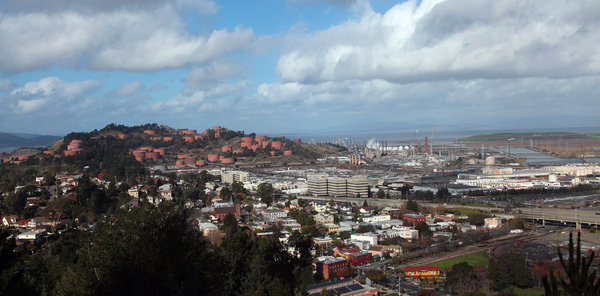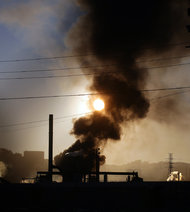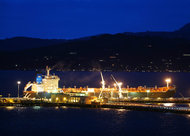| |
This is an interesting article but has a number of factual errors and erroneous embellishments. The City’s relationship with Chevron is complicated and complex, and therefore difficult to describe, but it’s not as bad as some people think.
- “…left-wing anticorporate activists seized control of the City Council and mayor’s office.” If he is describing the RPA, they were duly elected in a democratic process and reflect the composition of the Richmond electorate. No one “seized” anything.
- “Chevron says it wants to complete repairs this month at the refinery, where production has been cut in half since the fire. Not so fast, the city says.” In fact, the City issued the required permits before Christmas, after following a process of transparent evaluation directed by a resolution adopted unanimously by the entire City Council.
- “More significant, with the help of allies in environmental groups, Richmond has blocked Chevron’s plans for a major upgrade that the company says is essential to the refinery’s future.” In fact, the City of Richmond certified the EIR and issued all the permits for the major upgrade project in 2008. It was a successful CEQA lawsuit by environmental groups that stopped the project, not the City. The City of Richmond had nothing to do with it. Ultimately, the City Council unanimously adopted a resolution in early 2011 that urged Chevron to reapply for a permit for the project and committed to process it expeditiously, which the City has done.
- “In November’s election for three City Council seats, Chevron funneled $1.2 million into committees supporting three pro-Chevron candidates and opposing the company’s two most vocal critics, including Mr. Butt.” In fact, Chevron did not oppose me, it was Martinez and Langlois they opposed.
Together a Century, City and Oil Giant Hit a Rough Patch

Jim Wilson/The New York Times
COMPANY TOWN Chevron is the biggest employer and taxpayer in Richmond, Calif., and its red oil tanks still dominate the city’s skyline 110 years after the refinery was built.
By NORIMITSU ONISHI
RICHMOND, Calif. — The Chevron refinery’s massive oil storage tanks sit on the hills overlooking this small, impoverished city in San Francisco’s East Bay. Painted earthen red to blend with the natural surroundings, the tanks cannot help dominating the city’s skyline, much the way the oil giant itself has long shaped Richmond’s identity, economy and politics.

Enlarge This Image

Jim Wilson/The New York Times
At a meeting last month, some residents criticized the company after a fire at the refinery in August.
But Chevron’s grip on Richmond’s politics began to loosen a few years ago after left-wing anticorporate activists seized control of the City Council and mayor’s office. In an area of the country where high-tech companies tend to coexist peacefully with affluent municipalities, perhaps nowhere have locals and a giant corporation rubbed shoulders with such intensity as in Richmond.
If city leaders likened themselves to anti-oil-company fighters in Nigeria, Ecuador and other developing oil-rich nations, Chevron’s response would not have been out of place in the Niger Delta. It has spent millions of dollars on social programs and community-building here, as well as on friendly politicians.
Now, Chevron will get an inkling of whether its new strategy is working as the city weighs the company’s plans to rebuild a critical unit damaged in a major fire in August. Chevron says it wants to complete repairs this month at the refinery, where production has been cut in half since the fire.
Not so fast, the city says.
At a recent raucous public hearing, Mayor Gayle McLaughlin stood up to criticize Chevron, leaning on a pair of crutches after knee surgery. The mayor pointed out that the company had yet to provide documents requested by federal regulators, who are expected to release a report on the cause of the fire early this year. To applause, the mayor said, “In terms of response and transparency, I have concerns.”
At issue is Chevron’s choice of metal to replace a 5-foot-long, 8-inch carbon-steel pipe that became corroded and sprang a leak in August. The resulting fire sent plumes of black smoke into the air, spewing emissions of sulfur dioxide, as the authorities warned Richmond residents to stay indoors. Thousands went to emergency rooms with various health complaints. Chevron says it will compensate residents with valid claims for medical and property expenses, although it has not said how many of the 23,700 claims it has received will qualify.
The selection of a metal alloy called 9 Chrome will make the new pipe resistant to the kind of corrosion that affected the carbon-steel pipe, Chevron says; while the city’s own metal consultants confirm that the material meets industry standards, critics say there could be better choices.
The larger issue is the trust between Chevron and Richmond, which has deteriorated since the fire.
For most of the past century, Richmond was a loyal company town. As Chevron officials invariably point out, the refinery was built 110 years ago, three years before Richmond was incorporated as a city. Richmond grew around the refinery, which has remained the city’s biggest employer and taxpayer.
Then in the 1990s, transplants from nearby Berkeley and San Francisco began gravitating here, drawn to Richmond’s affordable rents and adding a radical tinge to the city’s traditionally moderate Democratic leanings. Ms. McLaughlin, a member of the Green Party, was elected in 2006, making Richmond the largest American city to be led by an official from her party; like-minded candidates grabbed seats on the City Council.
Not surprisingly, Richmond and Chevron became locked in lawsuits over the payment of various taxes. More significant, with the help of allies in environmental groups, Richmond has blocked Chevron’s plans for a major upgrade that the company says is essential to the refinery’s future.
“They went through a period of time when they took a very hard-line, confrontational position with the City of Richmond, and I don’t think it was working for them very well,” said Tom Butt, a councilman who has been critical of Chevron and who won re-election in November, despite the oil company’s support for three other candidates. “They were facing a situation where the majority of the City Council were not their friends, and so they decided to try a different position.”
Sean Comey, a Chevron spokesman, said the company felt the need to adopt a new strategy toward Richmond, though he did not go as far as to acknowledge that it was a direct response to the city’s changing politics.
“Probably about four, five years ago, we sat down to really reassess what the state of our relationship was with the community where we had been for more than 100 years — and it wasn’t where we wanted it to be,” Mr. Comey said.
Enlarge This Image


Jim Wilson/The New York Times
Chevron’s Barbara Smith spoke about repair plans.
Enlarge This Image

Jim Wilson/The New York Times
A tanker moored at the company’s dock.
Enlarge This Image

Jim Wilson/The New York Times
Mayor Gayle McLaughlin said at a meeting last month that she had concerns about Chevron’s response to a fire.
Enlarge This Image

Jim Wilson/The New York Times
Chevron sponsored a bike giveaway.
Chevron began increasing its social investments in Richmond, in everything from community gardens and holiday events to safety and educational programs. Next year, the company is planning to start a five-year, $15.5-million economic development and educational initiative on top of its social investments, which totaled $5 million this year.
“Richmond kind of gets into your blood,” said Andrea Bailey, Chevron’s manager of community engagement in Richmond. “There’s so much going on, and there’s this precipice of greatness. It’s exciting.”
Many, though, remain skeptical. Chevron’s community spending, they say, shares the same goal as its political contributions: buying support.
In November’s election for three City Council seats, Chevron funneled $1.2 million into committees supporting three pro-Chevron candidates and opposing the company’s two most vocal critics, including Mr. Butt. Two of the three Chevron-backed candidates won.
Mr. Butt did not face direct opposition from Chevron’s committee but said he still harbored “hard feelings” about Chevron’s political involvement.
“They want a City Council loyal to them,” he said. “I think it’s wrong for a corporation to pour that kind of money into a local election. Nobody can match that.”
Nathaniel Bates, a longtime councilman strongly supported by Chevron in the recent election, said that the company’s critics “just want to use it for political purposes.”
Mr. Bates praised the company’s increasing community spending. “They’re trying to be good neighbors,” he said.
It is too soon to tell whether Chevron’s new strategy of winning over Richmond will pay dividends. But in a recent tour of some locations where Chevron had focused its community spending, company officials sounded upbeat.
“I think we’re making some headway in this community,” said Mr. Comey, the spokesman.
Ms. Bailey, the manager of community engagement, added: “It’s interesting. After the fire, we’ve done some polls, and we still have a favorability with over 50 percent of the residents. That says a lot, especially after an incident like that.”
A version of this article appeared in print on January 3, 2013, on page A12 of the New York edition with the headline: Together a Century, City and Oil Giant Hit a Rough Patch.
|
|

